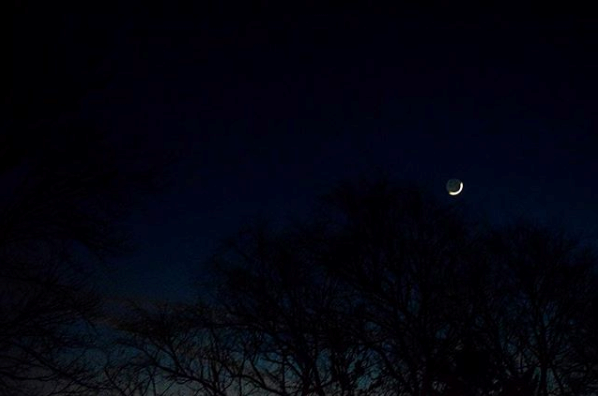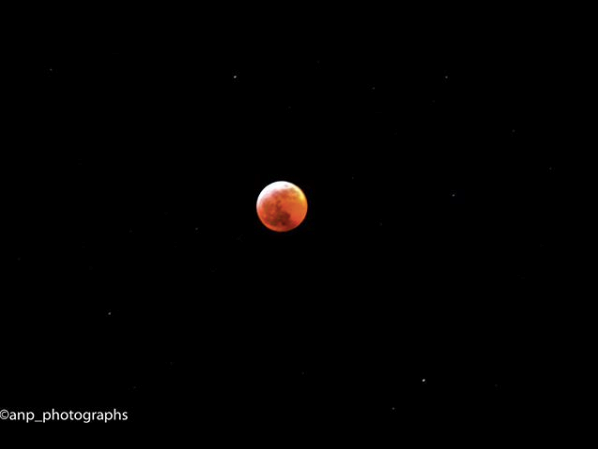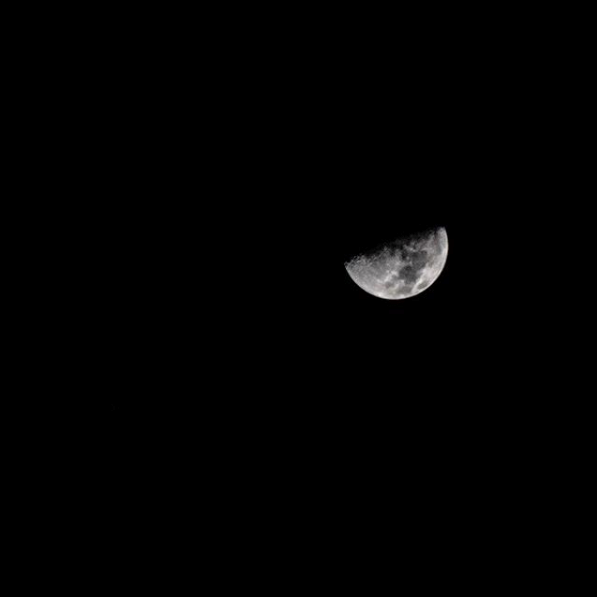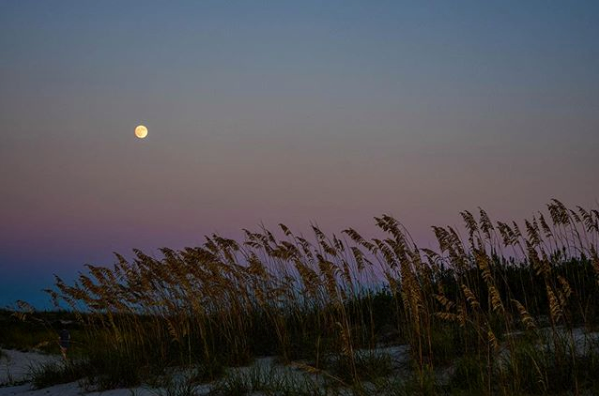THE MOON, OUR FRIEND
LAURA ST. ONGE
THE MOON, OUR FRIEND
Photographs by Annalise Peter Paul
I do not know what the moon means. Religionists, scientists, and spiritualists alike seem to have an idea. Wiccans know that the moon is holy, the Queen of the Night: wise, mysterious, and paradoxical by nature. Astronomers know that the moon is a large, spherical satellite orbiting the earth, reflecting the sun’s light. Spiritualists may have their own ideas; they may know it for this-and-that representative thing.
I do know that every time I look up into the night sky, I am underneath the moon. That is my place, it seems. When the moon is fully lit, it offers hope, as the nights often seem too dark to withstand. When the moon is crescent, it becomes a fancy, little chaise-lounge for my mind and soul to recharge while my body stays planted in the ground.
I do know that I am drawn to the moon and its travels, its colors and shapes, its magical merry-go-rounds around the earth’s merry-go-rounds around the sun, its reasons. The moon is so easily a character, a face, or a feeling. It reflects not only the sunlight but our own emotions, yet I do not know what is the moon and what is me.

The first day of the twenty-nine-day moon cycle is called the new moon. At this point, the moon positions itself in between the sun and the earth, so that the face of the moon that we see is shadowed. The moonlight is not there.
The moonlight is not there to illuminate the keys you’ve dropped on the way into the house. The moonlight is not there to accompany you in your late night contemplations. The night is despairingly dark. Yet, we call this darkness the dawning of something new, symbolic in a cliché, but, refreshing way… a hopeful way. Darkness is new, like the color of your eyelids before you wake, like the creation of the heavens and earth before light. The new moon does not occur on first night of moonlight. The new moon leaves a night as dark as it ever will be.
The moon is wise, we think. It is solid, consistent, reliable. What if it were not? What if we considered that the moon heeds to the wishes of gravity, like a puppy to a treat? The moon wiggles and waggles around the earth, wanting attention perhaps. We, on earth, admire it. We write songs and books about it, we draw it and talk to it sometimes… though, not quite as much as the sun: the largest, plumpest dog in the galaxy. What if the moon were jealous?
The first night of the moon cycle, the new moon, is the moon’s chance to steal away the attention from the sun by moving directly in front of it. “Here I am!” it yells. No one replies. The moon whimpers weakly, it feels invisible to the earth, and we, on earth, can’t really see it. So, the next night, the moon waxes out, a little bit out of the sun’s way. “Here I am!” the moon yells out again. The earth replies softly, and a sliver of the moon lights up with happiness. Each night, as the moon toddles farther and farther away from the sun, it lights up more and more until, nights later, the moon is fully lit. It sits on the other side of the sun; it can’t even see it anymore. It is full of happiness, smiling and wagging its tail. The moon shares all of its light with the earth that night.
The next few nights, the moon wanes on its merry way, but its light gets dimmer and dimmer, and the earth’s reply is softer and softer. Pouting, with its tail in between its legs, the moon asks, “Why does the earth love the sun more than me?” By the end of the last day of the moon cycle, the moon has forgotten that the earth sees it most clearly when it’s farthest from the sun. It wants to be loved again in spite of the overwhelming presence of the sun. The next night is the first of the moon cycle – the new moon – and the moon goes through its cycle of feelings again.
The moon has a new mind on the new moon, a full heart on the full moon.
On March 20th of 2019, I decide to sit outside on the creaky steps of my apartment while I wait for my boyfriend. As I look out past the street, a luminous glow lights the back of the trees, almost like a spotlight, casting great, tall shadows around me. If I move my head to the left, beyond the woven net of Sycamore branches, I see the moon. But this moon is different. It is bold and exuberant, unfathomable in brilliance and size. I can almost feel it, hear it, smell it. Every little circular indentation on its rounded face becomes clear, and suddenly, the moon is much less like a moon and more like… a delicious circle of cheese.
I hear Stephen’s footsteps on the sidewalk. They echo through the street. Happy to see each other, we go inside.
“Oh yeah, isn’t that cool? It’s the super moon!” he exclaims while he sees me peering through the window to have another glance at its hugeness. Being the charmingly intellectual physics major and astronomy-enthusiast he is, he goes on to tell me about how rare it is that the Spring Equinox and super moon occur on the same day. He mentions that the next one won’t happen until 2030. Wow, I think.
It makes me think that, although very romantic, George Bailey from “It’s a Wonderful Life” couldn’t really lasso the moon for Mary. Papa from Eric Carle’s “Papa, Please Get the Moon for Me” couldn’t really climb up his ladder to bring down the moon for his daughter, Monica. And I can’t cut out a slice to spread it on a cracker. However much joy the moon and its phases may bring us, it has places to be and routines to follow for its entire existence. It controls the tides and the waves and even our own lunacy, so I hear. It has patterns that I couldn’t possibly learn in a lifetime. It’s a very important and complicated piece of cheese.
On January 20th of 2019, my best friend Selin and I jump out of a party and into the freezing wind to see the blood moon with me. I’m visiting her at Cornell for the long weekend. It’s my mistake, as this is possibly the most freezing, snowy, windy weekend I can ever remember. But curiosity gets the best of me. There is nothing I wouldn’t do, I told myself, to see the moon look like a drop of blood, or maybe a ruby suspended in the sky.
The previous day, my mother had called me to tell me about it. “You have to experience the night sky in your life before all of the smog covers it,” she said half-jokingly. A valid point, although I required no persuasion to do so. “Yeah, no, of course I will, that sounds amazing!” I exclaimed. “I wonder why it would turn red like that.” She didn’t know either. She reminded me that Google was a close friend to both of us.
Our close friend informed us that a blood moon is a lunar eclipse. The red color of the moon arises from the distorted light waves of the sun, going through the earth and coming out broken up and weaker than before. Subsurface scattering. It’s much like when you hold a finger to the surface of a flashlight and it turns bright red like the coil of a stove top.
Our time outside, without our coats, is brief. We step out onto the barely-plowed street and stretch our necks out to see the blood moon behind the roof of the house. It isn’t quite red, with all of the light it emits, it’s more pinkish orange. It looks like the head of a push pin, I think. A shiny, orange push-pin… “Okay, cool!” I hear Selin exclaims quickly, with a slight crack in her voice from the shivering. She motions for us to go back inside. I can’t help but stare at it longer – against the dead black night sky. How pretty, I think. It’s too bright to look like blood, or the ruby I had imagined it would look like. It feels like I’m looking at the sky with rose-colored glasses, and that’s exactly how I feel about the rest of that night… really, as I look back, at most nights.
I hear the wooden staircase creek as Selin heads back up the stairs to the house. I follow.

On January 31st, 2018, there is a blue moon, meaning that it’s the second full moon of the calendar month. Not only is it a blue moon, but it is also a super blood moon – a super blood blue moon. This only ever happens less than once in a blue moon, maybe once in a lifetime (well, depending on how long you live).
I am sound asleep. I turn my back on the moon. I wake up to the sun.
The moon is waxing when the light shines mostly on the right side – in the beginning half of the moon cycle, when the light section of the moon is getting bigger.
The moon is waning when its light shines on the left – the last half, when the moonlight is dimming.
The moon is crescent when… it looks like a crescent, and more than half of the moon is covered by shadow.
The moon is gibbous when more than half of the moon is lit up, and only a sliver is shadowed.
The crescent shape is iconic and soothing, though. My friends have tattoos and jewelry of it. Yours may too. We like to imagine that someone, perhaps a little boy with a fishing rod, can sit comfortably inside the crescent and look down on all of us.
I don’t see many pictures of a gibbous moon, I realize. And when I think about it, I see a gibbous shape as almost or the anticipation of a perfect circle. A perfect circle is satisfying, like a full moon. Anything short of perfect can often be… dissatisfying.
I would like to say that I find the gibbous shape as appealing as the crescent – to find some unique way to look at it to make everyone appreciate it more.
If you looked at the phases of the moon like the seasons, as if the full moon is summer and the new moon is winter, the waxing gibbous would be like the warm end of spring, when everything is colorful and flower petals fall from the trees like soft, warm snow. The waning gibbous is the warm beginning of fall, when the air becomes just cool enough that you get happy to cuddle under a warm blanket with a hot tea, and the leaves begin to turn yellow and orange and red and just a select few fall to the ground for you to crunch on when you take a step.
I would be lying if I said that I truly feel that way about a gibbous moon. Sometimes I crave perfect, but perfect rarely, if ever, exists.

We, on earth, all see the same face of the moon. It circles around us, turning in a way that an axis passing through the center of the moon and into the earth’s core will always stay straight. We all share the moon’s soft, careful face, but sometimes, it appears to be different. Sometimes a full moon in the winter is eerie while a full moon in the bright, green summer is joyous. When people lived without the power of electricity, the moonlight was essential to harvesting and hunting patterns. Full moons offered a hand to those proactive folks who worked outside into the hours of the night. Native Americans gave names to these full moons throughout the year, depending on how the moon would assist them.
A harvest moon in September gives enough light for farmers to gather the fall crops during the
night. Neil and Pegi Young hold each other romantically under its spotlight.
A hunters moon in October gives enough light for hunters to see deer, fattened from October’s
stolen harvest, exposed in the negative space from the new fallen leaves.
A beaver moon in November gives enough light for Algonquin beaver trappers to wait for
catches, inspired the by idea of wrapping up in cozy, warm, winter furs.
A cold moon in December gives enough light for all restless sleepers to overthink, tossing and
turning, shivering in their beds.
A wolf moon in January gives enough light for the wandering canines of the world to freely cry
out, suffering in hunger, perhaps seeking for the voice of another.
A snow moon in February gives enough light for the face of the deep, white ground to become a
mirror. A sparkling mirror of the moon.
A worm moon in March gives enough light for all of the pink squiggly-squagglies to squirm their
way out into the newly thawed and gushing earth.
A pink moon in April gives enough light for the first flowers to consider popping up. They climb
carefully out of their green cases and into the arms of the blue light.
A flower moon in May gives enough light for those tiny flowers and their statelier friends in the
bushes and trees to sing to each other while we sleep.
A strawberry moon in June gives enough light for Algonquin berry pickers to continue plucking
well into the night, coming home with sweeter, stickier fingers than the days before.
A buck moon in July gives enough light for a stag’s antlers to grow back fully. He is ready to
fight and frolic as he pleases in the tall, green July grass.
A sturgeon moon in August gives enough light for Great Lake fishers to hook the water-dwelling
dinosaurs of North America, their silver scales turning into glitter under the moonlight.
It is the same full moon we see, but with a different mood – the same face lit up by the same rays of sun, yet our emotions around it change. Nonetheless, it still waits for us, up in the sky. Its light comes and goes predictably during the course of a month or so. It shows us its face and lends a hand reliably, like a friend we have, or perhaps have always wished to.

We can rest on the idea that the moonlight goes away but comes back to us over and over, like only a few things in life. More often, we find ourselves not knowing how long things will be with us, or when they go – if they’ll ever come back to us again. With the moonlight, we can count down its company. If the night sky becomes dark and gloomy, we know that in just time it will be light again. Sometimes, even, the light will be more brilliant than ever like a super moon, or rich like a blood moon. And then days later, the light will fade… only to come back again.
References:
NASA’s Scientific Visualization Studio. “Moon Phase and Libration, 2018.” NASA, Web. 2018.
“Phases of the Moon and Percent of the Moon Illuminated.” The United States Naval
Observatory, Web. 2017.
Trundle, Kathy Cabe, and Thomas H. Troland. “The moon in children’s literature.” Science and
Children 43.2: 40. 2015.
“When Is the Next Full Moon?” Old Farmer’s Almanac, Web.
